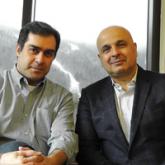Video

Cenk Ayata, MD, & Messoud Ashina, MD
Does the blood–brain barrier open during migraine? Dr. Alan Rapoport speaks with Dr. Cenk Ayata and Dr. Messoud Ashina, who take opposites sides...
Although early studies provide a basis for the hypothesis that CSD is associated with migraine and might disrupt the BBB, clinical studies have consistently failed to link CSD with evidence of BBB disruption, said Dr. Ashina. In 1981, Olesen and colleagues reported cerebral hypoperfusion, a potential sign of CSD, followed by transient increases in cerebral perfusion (ie, hyperemia) during experimentally induced migraine aura.
“In some patients, headache disappeared when the hyperemia was observed, so there was no correlation,” said Dr. Ashina. Moreover, no changes in blood flow were observed when the same studies were conducted in patients with migraine without aura, and none of the studies reported changes in the permeability of the BBB in migraineurs with and without aura, according to Dr. Ashina. He and his colleagues at the Danish Headache Center remain active in this research.
He cited a 2017 study by Hougaard et al of 19 migraineurs with aura and 19 migraineurs without aura. Tissue perfusion in various parts of the brain was measured to assess change in BBB permeability. Patients underwent 3-T MRI during and in the absence of migraine attacks. “In aura patients, we found hyperperfusion in the brainstem during the headache phase of migraine with aura, while the BBB remained intact during attacks of migraine with aura,” said Dr. Ashina. Using sensitivity analyses, they looked for changes as small as 15%, but found nothing.
Other studies have looked more indirectly at the likelihood that the BBB is disrupted during migraine, but these, such as one that evaluated extracranial arterial dilatation during migraine attacks, have also been negative, according to Dr. Ashina. Studies of putative mechanisms for BBB disruption, such as one that evaluated the upregulation of matrix metalloproteinases, have also failed to support BBB disruption. “Nothing out there provides any evidence whatsoever that relates directly to BBB opening during migraine attacks with or without aura,” said Dr. Ashina.
If the BBB undergoes a transient disruption during migraine, it remains unclear whether this disruption is clinically meaningful or provides new opportunities to time treatment. The introduction of monoclonal antibodies for migraine may inspire the research needed to resolve this question.
Dr. Ashina has financial relationships with Alder BioPharmaceuticals, Allergan, Amgen, Eli Lilly, Novartis, and Teva. Dr. Ayata has no financial relationships relevant to this topic.
—Ted Bosworth
Amin FM, Asghar MS, Hougaard A, et al. Magnetic resonance angiography of intracranial and extracranial arteries in patients with spontaneous migraine without aura: a cross-sectional study. Lancet Neurol. 2013;12(5):454-461.
Amin FM, Hougaard A, Cramer SP, et al. Intact blood-brain barrier during spontaneous attacks of migraine without aura: a 3T DCE-MRI study. Eur J Neurol. 2017;24(9):1116-1124.
Ashina M, Tvedskov JF, Lipka K, et al. Matrix metalloproteinases during and outside of migraine attacks without aura. Cephalalgia. 2010;30(3):303-310.
Ayata C, Lauritzen M. Spreading depression, spreading depolarizations, and the cerebral vasculature. Physiol Rev. 2015;95(3):953-993.
Hougaard A, Amin FM, Christensen CE, et al. Increased brainstem perfusion, but no blood-brain barrier disruption, during attacks of migraine with aura. Brain. 2017;140(6):1633-1642.
Olesen J, Larsen B, Lauritzen M. Focal hyperemia followed by spreading oligemia and impaired activation of rCBF in classic migraine. Ann Neurol. 1981;9(4):344-352.

Does the blood–brain barrier open during migraine? Dr. Alan Rapoport speaks with Dr. Cenk Ayata and Dr. Messoud Ashina, who take opposites sides...

